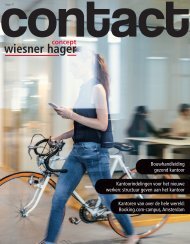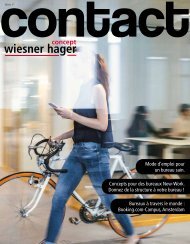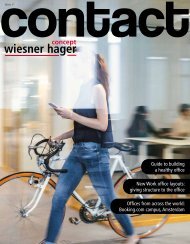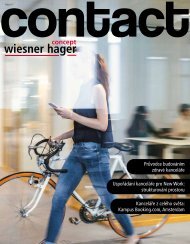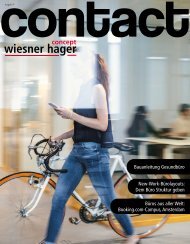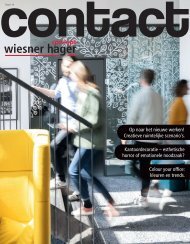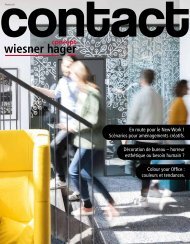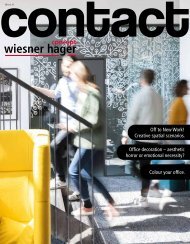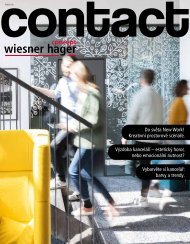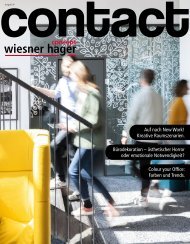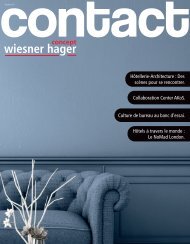contact office magazine #28
Artificial intelligence has long since found its way into the office day-to-day. But watch out: Experts give rise to concerns that we must not neglect our classic human abilities such as touch, communication and emotional competence during the increasing digitisation. One requires the other. At the end we ask ourselves: What effect does everything have on the design of our workspaces?
Artificial intelligence has long since found its way into the office day-to-day. But watch out: Experts give rise to concerns that we must not neglect our classic human abilities such as touch, communication and emotional competence during the increasing digitisation. One requires the other. At the end we ask ourselves: What effect does everything have on the design of our workspaces?
Create successful ePaper yourself
Turn your PDF publications into a flip-book with our unique Google optimized e-Paper software.
Issue 28<br />
Welcome to the age of the<br />
(artificially) intelligent <strong>office</strong>.<br />
Open units instead of open space.<br />
Office climate conference.<br />
Are you sitting comfortably? Stand up!
If you’re saying AI, you<br />
also have to say EQ.<br />
Concepts such as “robo advisor”, “big data” or “artificial intelligence”<br />
make many people feel uneasy. This is what we are<br />
tackling intensively in the latest issue of our <strong>magazine</strong> with the<br />
topic of digitisation vs. emotional intelligence (EQ) and showing<br />
that a gradual implementation of artificial intelligence in<br />
the everyday <strong>office</strong> can really bring about opportunities.<br />
Of course, with all new opportunities, the question that<br />
springs to mind is whether there are even abilities left that we,<br />
as humans, still have over the machines: Learn more on page 8.<br />
In the article, “Open units instead of open space”, we present<br />
innovative <strong>office</strong> designs which can be adjusted ideally to the<br />
needs of employees in the age of digitisation. As the quality<br />
of activity-based working is not just based on a good working<br />
climate, but also on a perfect room climate, we have summoned<br />
the “Office Climate Conference” on page 13. Here,<br />
five demands are presented which you should observe for a<br />
pleasant room climate in the <strong>office</strong>.<br />
Because our love for the <strong>office</strong> also goes through the stomach,<br />
we are tackling the good, but not at all old, canteen. This isn’t<br />
just a place to provide nourishment any more, for example,<br />
for our clients Koenig & Bauer AG. It is a meeting place and a<br />
place of retreat to motivate and inspire us.<br />
And because we think a lot of inspiration and curiosity, we<br />
visited the Uber head <strong>office</strong> in far-off Hong Kong and cast<br />
a curious glance over a desk at Frankfurt architecture <strong>office</strong><br />
schneider+schumacher. Inspiring reading is guaranteed!<br />
Welcome to the age of the (artificially) intelligent <strong>office</strong> ............ 04<br />
Human competence vs. artificial intelligence .............................. 08<br />
Open units instead of open space ............................................... 10<br />
Office climate conference ............................................................ 13<br />
Reference story: Koenig & Bauer AG ........................................... 14<br />
New work: new break ................................................................. 16<br />
Something useful for the <strong>office</strong> day-to-day ................................. 19<br />
Offices from around the world: the UBER<br />
head <strong>office</strong> in Hong Kong ............................................................ 20<br />
What's on your desk, schneider+schumacher? ........................... 23<br />
The new efficiency: working while standing ............................... 24<br />
Showroom ................................................................................... 26<br />
Markus Wiesner<br />
Publisher: Wiesner-Hager Möbel GmbH, Linzer Straße 22, A-4950 Altheim, T +43/(0)7723/460-0, altheim@wiesner-hager.com,<br />
www.wiesner-hager.com, thinknewwork.com; Design/Editing: Wiesner-Hager, plenos creative; Layout: plenos creative, plenos.at;<br />
guest author: Wojciech Czaja; typing and printing errors reserved; 05/2019.<br />
2 <strong>contact</strong><br />
<strong>contact</strong> 3
Office concepts<br />
Welcome to the<br />
age of the (artificially)<br />
intelligent <strong>office</strong>.<br />
Artificial intelligence has long since found its way into the <strong>office</strong> day-to-day. But watch out: Experts give<br />
rise to concerns that we must not neglect our classic human abilities such as touch, communication<br />
and emotional competence during the increasing digitisation. One requires the other. At the end we<br />
ask ourselves: What effect does everything have on the design of our workspaces?<br />
“How can I help?”,<br />
asks Robert. “Alright.<br />
I will show<br />
you the detailed<br />
plan for pillar<br />
5.3 in the second<br />
basement garage.”<br />
The plan is<br />
barely open, and<br />
it transpires that<br />
the galvanised<br />
steel vehicle bumper<br />
buffer device<br />
has been produced<br />
incorrectly and<br />
correspondingly<br />
installed incorrectly.<br />
“I am sending the<br />
fault pictures that were<br />
just produced with your<br />
digital signature directly to<br />
the construction <strong>office</strong>. Should<br />
I order a replacement part? Alright.<br />
I am ordering a replacement bumper<br />
buffer device component for pillar 5.3 in<br />
the second basement garage. Delivery in ten<br />
working days. Can I do anything else for you?”<br />
Robert wears turquoise overalls and an orange construction<br />
helmet on his head. He also has an irresistible<br />
smile like in a toothpaste advert and a pleasant, sympathetic-sounding<br />
voice like an audiobook. “Robert<br />
is our latest development for simplifying production,<br />
assembly and service processes on the construction<br />
site,” says Benjamin Schwärzler, Managing Director<br />
of Vienna-based company Tablet Solutions, as well as<br />
founder and inventor of the digital<br />
construction site assistant<br />
WorkHeld, which is already<br />
relied upon by companies<br />
such as Siemens,<br />
Daimler and Austrian<br />
cable car manufacturer<br />
Doppelmayr.<br />
With Robert,<br />
workers on the<br />
construction site<br />
don’t have to<br />
type and the<br />
reporting<br />
and<br />
remedy of faults can now be achieved much more<br />
quickly and efficiently than before. It means that we<br />
can avoid massive friction losses in communication<br />
and in construction site operation.” Aside from fault<br />
management, the WorkHeld areas of application<br />
cover material and system management, construction<br />
site logistics, appliance service, time and expenses<br />
recording as well as any form of automatic reports<br />
from structure construction and facility management.<br />
Thanks to artificial intelligence, the app is capable of<br />
independent learning, according to the manufacturer.<br />
So, the question inevitably presents itself: Will Robert<br />
have one day replaced humans?<br />
Experts are expecting the use of artificial intelligence<br />
(AI) to result in around 48 billion Euro of additional<br />
production and around 38 billion Euro of additional<br />
added value by 2025 in Austria alone. “Visibility and<br />
connectivity are the key characteristics of a smart factory,”<br />
says Roland Sommer, Managing Director of the<br />
Industry 4.0 platform, founded in 2015, which has set<br />
the goal of making the best use of the new technological<br />
developments and innovations in digitisation and<br />
shaping the transition for society at large in a socially<br />
sustainable manner. “The employees have access to<br />
schedules, quality data, stock statuses and demand<br />
alterations at all times. The individual departments<br />
of the company can be connected with each other<br />
electronically to collaborate and increase productivity<br />
and efficiency.”<br />
And yet, most people are afraid when the subject of<br />
AI crops up. According to a study in Germany, 41<br />
percent of employees fear a threat to the survival of<br />
humanity because of the new applications of AI, 25<br />
percent are afraid that intelligent computers will take<br />
their jobs, and 17 percent believe that their privacy is<br />
under threat. “Here, the fear of world domination by<br />
robots and a digital precarity is based on uncertainty<br />
of everything new, and actually, this is something that<br />
applies to every innovation,” writes German businessman<br />
and SPD representative for medium-sized<br />
businesses Harald Christ in a guest commentary in<br />
the Handelsblatt newspaper. “When the railway was<br />
invented, academics believed that humans were in<br />
danger of mental disorders at speeds of more than 30<br />
kilometres per hour. Even the car was treated with<br />
hostility at first. Terrified citizens dug up roads or<br />
stretched cables across them at the end of the 19th<br />
century to prevent the new motor carriages.” But<br />
looking back, says Christ, no innovation has ended in<br />
a catastrophe yet. No innovation has ever reduced our<br />
4 <strong>contact</strong> <strong>contact</strong> 5<br />
© Shutterstock
Office concepts<br />
wellbeing. And no innovation has brought about mass<br />
unemployment. In order for the disruption currently<br />
taking place to be an advantage to humans and not<br />
cause harm, we require a corresponding analysis of the<br />
topic. “The most important thing is to remove the negative<br />
sting from digitisation and artificial intelligence<br />
and to recognise the transition as an opportunity and<br />
support,” says organisation and work psychologist<br />
Bettina Wegleiter from Vienna. “Ideally, AI takes<br />
over routine activities that no one really wants to do:<br />
organisation, commercial tasks, number and data<br />
checks. This frees up resources for new, more efficient<br />
and more highly qualified jobs in the company. But<br />
yes, of course it will be necessary to swim with the<br />
current here. If you don’t participate, sooner or later,<br />
you will lose <strong>contact</strong>.” This also corresponds with the<br />
appraisal of Guido Zimmermann, Senior Economist<br />
at Landesbank Baden-Württemberg (LBBW): “The<br />
biggest problem will not be that we run out of work,<br />
but that the type of work will change, and we have to<br />
adjust our behaviour to this in good time.”<br />
The biggest changes are to be expected in manufacturing<br />
industries, in the TMT sector (technologies, media,<br />
telecommunication) as well as in fintech. Today, a<br />
large proportion of investment advice has already been<br />
taken over by robo advisors, meaning by algorithms<br />
which calculate the best form of investment for the<br />
end customer regarding duration, investment amount<br />
and readiness to assume risk, and automatically trigger<br />
the corresponding investments. Similar behaviour is<br />
seen for complex legal cases, job application processes<br />
or online customer service, for example. Online<br />
retailer Zalando have saved themselves the cost of<br />
250 marketing specialists and replaced them with<br />
algorithms. And while China Merchants Bank used to<br />
employ around 7,000 workers to take care of customer<br />
enquiries, one single robot now handles up to two<br />
million communication cases per day automatically.<br />
IT programmes entered our working day a long time<br />
ago, such as Datev (software cloud for tax consultants,<br />
auditors and solicitors), Ross (assistance system<br />
for court judgements), Amelia (Q&A in customer<br />
service), Xander (emotion recognition for people) and<br />
even Cogito, which is programmed to study human<br />
behaviour, assess emotions and indicate to employees<br />
in call centres when they are becoming impatient or<br />
unfriendly. Apple’s Siri, Amazon’s Alexa and Google’s<br />
Home will be able to give you a proper telling-off in<br />
future. Very spooky. An OECD study published in<br />
2018 reaches the conclusion that in developed countries,<br />
every second job will be significantly affected by<br />
automation. From today’s perspective, 14 percent of<br />
all jobs will supposedly be “highly automatable” and<br />
therefore at particular risk. In the USA, the proportion<br />
is said to be even higher, according to a detailed<br />
study by economist Carl Benedikt Frey and computer<br />
scientist Michael Osborne. A tool also developed<br />
by the OECD now helps employees to forecast the<br />
effects on their own job. An initial self-test reveals the<br />
gravest of future scenarios for copywriters and journalists.<br />
Thanks, future!<br />
“The development cannot be stopped, but for the sharing<br />
of functions between man and machine to work<br />
well, careful support is required,” explains Christian<br />
Blind. For quite a while now, the Salzburg-based work<br />
psychologist has been working with computer-assisted<br />
intellectual work (in German: rechnergestützte geistige<br />
Arbeit or RGA) and its effects on everyday <strong>office</strong><br />
work. “You cannot just slap an Alexa down in front<br />
of an employee and wait to see what happens. When<br />
implementing human-centred technologies, we must<br />
use tools which allow a gradual appropriation of innovations<br />
in a way which is transparent and comfortable<br />
for the person.” Some standards such as ISO 14915<br />
and DIN EN ISO 13407 should standardise usability<br />
engineering and the user-friendliness of new software.<br />
“Because,” says Blind, “at the beginning, most people<br />
do not know all the things that they do not know.”<br />
In the end, the question is: What effects does AI<br />
actually have on the physical form of our workspaces?<br />
In Switzerland, this is precisely the question which<br />
students at colleges and universities are confronted<br />
with intensively in their syllabus today. “If we don’t<br />
raise awareness, the topic can tip over into fear and<br />
rejection,” says Sibylla Amstutz, Professor of Technology<br />
and Architecture and head of the Architecture<br />
and Interior Architecture research group at Lucerne<br />
University of Applied Sciences and Arts. “This is why<br />
we are trying to educate our students in such a way<br />
that they can integrate the new technologies naturally<br />
into their expertise. We are researching in an application-oriented<br />
manner and advise companies in change<br />
management processes and implementing Scrum, new<br />
technologies and artificial intelligence.”<br />
The most important finding from our joint workshops:<br />
“Within the context of increasing digitisation,<br />
there is a longing for physical, haptic, perceptible and<br />
emotionally moving spaces – and this is a clear countertendency<br />
to the digital, artificial and virtual developments,”<br />
says Amstutz. “The individual workspace,<br />
as we know it, is being forced more and more into the<br />
background. Even classic meeting rooms with a cleandesk<br />
policy will lose their importance in the future.<br />
Instead, new collective and communication spaces<br />
will come into existence where, like with Scrum, usual<br />
creative, project-related traces can be left on the tables,<br />
on the walls, in the rooms. It is a question of places of<br />
interpersonal encounter – with all the emotional and<br />
physical presence.”<br />
The professor has a nice anecdote at down pat: In the<br />
earliest projects which she supported in the course<br />
of a digital change, the young colleagues tended to<br />
want brighter colours, more natural materials<br />
and a generally cosier work setting than the<br />
predominantly older colleagues who had<br />
been with the company for a longer<br />
time but had fewer points of <strong>contact</strong><br />
with new technologies. “In one<br />
of our projects, there was even a<br />
small team of very young people<br />
who walked through the <strong>office</strong><br />
each day and tended to the plants<br />
together. This gives us hope in<br />
the event of artificial intelligence,<br />
doesn’t it?”<br />
Wojciech Czaja<br />
6 <strong>contact</strong><br />
<strong>contact</strong> 7
Office life<br />
Human competence<br />
vs. artificial intelligence:<br />
Where we still have an<br />
advantage over machines.<br />
The digitisation of the work environment is moving forward at a fast pace. The automation<br />
of knowledge work means that in times of big data, intelligent IT systems<br />
are increasingly able to make decisions requiring analytical skills better than we<br />
humans ourselves. And in a reliable manner, in real time. As a consequence, many<br />
typical jobs are being replaced by digital innovations. Of course, this triggers the<br />
question of whether there will even be areas where humans can pit themselves<br />
against the machines. And which professions will even still exist over the next<br />
few years.<br />
Professor Helmut Karner, business consultant and<br />
co-founder of Föhrenbergkreis, believes that, in spite<br />
of automation, our work will not come to an end. He<br />
sees the future of human competences in the development<br />
of concepts and creativity-enhancing areas:<br />
teamwork, emotions and empathy. “In a few areas,<br />
humans are still superior to machines, particularly in<br />
creativity: Emotional or typical human competences<br />
will play a very central role in the future.”<br />
From an academic point of view, Dr Birgit Feldhusen,<br />
head of the “Agile Organisations & Collective Leadership”<br />
course at Danube University Krems: “Artificial<br />
intelligence cannot question its own way of thinking.<br />
It further develops in the mental framework that we<br />
give it. However, it could possibly make available<br />
applications which make it easier for us humans to<br />
question our ways of thinking.” In the acquisition<br />
and optimisation of these competences, artificial<br />
intelligence can be helpful, but it will not succeed in<br />
possessing them itself.<br />
More specifically, the two authors, Adam J. Gutstein,<br />
Vice President of business consultancy company PwC,<br />
and his colleague John Sviokla, head of the thinktank<br />
“The Exchange” at PwC, present in detail the superior<br />
human abilities. In Harvard<br />
Business Manager ( January<br />
2019 issue), the two present<br />
seven competences which<br />
humans master better than machines<br />
both now and will do so<br />
in the foreseeable future as well.<br />
Communication<br />
Storytelling in bullet points: People<br />
can be moved to action with stories.<br />
Above all when we use an effective<br />
communication cocktail made up of<br />
explanations, facts, rhetoric and science,<br />
and appeal to the emotions of the listener.<br />
Think about Steve Jobs who presented the<br />
first iPod with the promise of 1000 songs in<br />
your trouser pocket. The ability to stimulate an<br />
image-rich language and the power of imagination<br />
is part of human nature and machines will<br />
struggle to mimic it.<br />
Contents<br />
Successful communication requires<br />
the corresponding content. If you<br />
are an expert in your field, you<br />
are well ahead of the machine<br />
and are always in demand. Even<br />
if you can find out everything<br />
these days using a search engine,<br />
the demand for experts is greater<br />
than ever. The difference lies in<br />
the dynamics of the subject area:<br />
A human expert can combine<br />
contents and specialist knowledge,<br />
and thus pass on new<br />
knowledge to others.<br />
Context<br />
Automated systems can only take<br />
action and make decisions within<br />
the framework defined by the<br />
developer. They will only recognise<br />
connections that are known to them.<br />
This extensive understanding of context<br />
can, as before, only be perceived<br />
and assessed by a human. The creative<br />
innovation of humans is required to<br />
expand this framework.<br />
Emotional competence<br />
There have now been experiments where<br />
artificial intelligence attempts to interpret<br />
human emotions. But the human feelings<br />
are a complex topic – it becomes even more<br />
complex when interpersonal relationships<br />
and group dynamics come into play. It is<br />
almost impossible for artificial intelligence<br />
to develop emotional<br />
competence in order to<br />
recognise emotions<br />
in others and to react to them accordingly. It can<br />
neither engage in emotionally complex situations, nor<br />
persuade other people.<br />
Teaching<br />
Computer support has contributed greatly to improving<br />
the quality of education. However, machines<br />
cannot individually cater to the potential of the<br />
employee and support this. In personal collaboration,<br />
points of weakness or gaps in knowledge can be better<br />
identified and counteracted accordingly.<br />
Relationships<br />
Relationships can be complicated, but first and foremost,<br />
they give us humans support, confirmation and<br />
self-confidence. We usually maintain our strongest<br />
relationships with our family and friends. Professionally,<br />
we talk about networks – mainly more superficial<br />
than in a private setting, but still essential for<br />
success. Are virtual <strong>contact</strong>s on Facebook, LinkedIn,<br />
etc. not enough? Not a chance: The best networks and<br />
relationships are still maintained personally.<br />
Moral compass<br />
Even if machines are efficient, there are no algorithms<br />
which decide according to ethical values. Artificial<br />
intelligence is refused the ability to make a moral decision<br />
because of a lack of emotional competence. For<br />
humans – above all those in management positions – a<br />
well-functioning moral compass is becoming more<br />
and more important in a world full of automated<br />
processes.<br />
8 <strong>contact</strong><br />
© Shutterstock<br />
<strong>contact</strong> 9
Office Life concepts<br />
Open units<br />
instead of open space.<br />
© Visualization:<br />
Studio Perspektiv, Prague<br />
The concept of open space is particularly fashionable just now. For some, it is an exciting vision of<br />
a digitised work environment. For others, it sounds more like a dangerous threat, equal to that of<br />
open-plan <strong>office</strong>s and desk sharing. So how much openness does a contemporary <strong>office</strong> need? A<br />
critical analysis between errors and misdirection.<br />
their computers, huddling under their headphones<br />
and silently completing their work.<br />
So, does this mean that we are moving back towards<br />
the traditional cubicle <strong>office</strong>? With a large desk and<br />
opulent linear metres of storage space? Hardly, even<br />
if the cubicles are, as before, the most popular <strong>office</strong><br />
design among employees. According to the Fraunhofer<br />
institute, just under 50 percent of people still work<br />
in classic <strong>office</strong>s with cubicle structures. Apart from<br />
that, each change is initially viewed with a sceptical<br />
eye. As before, the cubicle <strong>office</strong> is the manifestation of<br />
hierarchy, status and the claim of ownership for many<br />
employees.<br />
Yet even in the classic cell <strong>office</strong>, the negative aspects<br />
are also serious: In many company areas, the rigid<br />
cubicle structure prevents modern, collaboration-oriented<br />
working processes. There are also high structural<br />
costs and poor spatial efficiency to consider – and this,<br />
as stated above, with an actual workplace presence of<br />
barely more than 30 to 50 percent.<br />
One-person cubicles completely support concentrated<br />
working; with two-person or four-person cubicles, the<br />
situation is completely different: Here, communication<br />
and the associated noise is perceived as even more<br />
disruptive than the base level of noise in open room<br />
structures.<br />
The paradox in the discussion “open plan versus cubicles”<br />
is that the presumed strengths of the respective<br />
<strong>office</strong> design are perceived in completely the opposite<br />
way in reality.<br />
© Visualization:<br />
Studio Perspektiv, Prague<br />
In order to come close to possible answers, we must<br />
first ask the question of where and how <strong>office</strong> workers<br />
actually work today. Not that they can be lumped<br />
together as one – a field sales employee<br />
has a completely different daily routine<br />
from a bookkeeper – but it is a fact<br />
that permanent workplaces on average<br />
are only used one third of the time during<br />
the course of a working week. We<br />
spend the other two thirds away from<br />
our (own) desk in meetings, breaks,<br />
co-working areas, working from home<br />
or travelling. We could even continue<br />
the list. Experts have coined the term<br />
“activity-based working”: We use<br />
the working locations which are best<br />
suited to our current activity.<br />
Cubicles or open plan: Which<br />
<strong>office</strong> design is better?<br />
“Now, this is definitely the wrong question,” says Bernhard<br />
Kern, Managing Director of Roomware Consulting<br />
– a company which deals with <strong>office</strong> development<br />
and design. “The right <strong>office</strong> design is determined by<br />
Employees<br />
are hiding behind<br />
their computers,<br />
huddling<br />
under their<br />
headphones and<br />
silently completing<br />
their<br />
work.<br />
the respective organisation and must suit the company<br />
culture. The decision about <strong>office</strong> design always goes<br />
together with the future ways of working.”<br />
Open-plan <strong>office</strong>s are very popular among<br />
many companies because, unsurprisingly,<br />
they are cheaper. A rule of thumb states that<br />
the area costs are around one third lower<br />
than for <strong>office</strong> buildings with classic cubicle<br />
structures. However, there are a lot of negative<br />
facets to this economic aspect in any<br />
case. Relabelling open plan as open space<br />
also doesn’t help. The problems with open<br />
space are known and are difficult to get under<br />
control. Noise irritation, disruptions to<br />
concentration and – something which may<br />
sound paradoxical as it’s currently sold as a<br />
great advantage – the impairment of communication:<br />
In a current Harvard study, it<br />
was established that personal conversations<br />
in open spaces, meaning open-plan <strong>office</strong>s,<br />
have reduced by up to 70 percent compared with<br />
small-structured <strong>office</strong>s. At the same time, digital<br />
communication via Messenger or email increased by<br />
67 percent. The result: Employees are hiding behind<br />
10 <strong>contact</strong> <strong>contact</strong> 11
Office concepts<br />
Office life<br />
Open units bring communication and<br />
concentration into balance.<br />
In his book, “2025 – So arbeiten wir in der Zukunft”<br />
[This is how we work in the future], futurologist Sven<br />
Gabor Janszky assumes that in the future, there will be<br />
three essential room scenarios in <strong>office</strong> buildings: silent<br />
rooms for highly concentrated work, highly technological<br />
communication rooms for real and virtual meetings<br />
as well as co-working spaces which offer an ideal<br />
environment for collaboration. While the first two<br />
of these room scenarios are designed as classic cubicle<br />
solutions, co-working areas leave a great deal of leeway<br />
for organisation and design in the spatial implementation.<br />
Here, one thing can be observed most of the<br />
time: They are neither open plan nor cubicles. Experts,<br />
such as Prague architect Martin Stara, whose architecture<br />
<strong>office</strong> Studio Perspektiv specialises in new-work<br />
<strong>office</strong> designs, are talking about open units here. These<br />
are rescaled, small-structured yet open room areas<br />
which above all focus on collaboration: project rooms,<br />
libraries, work cafes, communication islands, retreat<br />
niches, team <strong>office</strong>s, lobbies, gardens, living rooms, etc.;<br />
the design implementation possibilities are incredibly<br />
diverse. Open units are the answer to activity-based<br />
working. They create the freedom to select the ideal<br />
working location for your activity. Here, the personalised<br />
desk only has a subordinate role. Storage space is<br />
even less important because notebooks and the cloud<br />
take on this function.<br />
Open units are an integrative component of an open<br />
room design, but structured into smaller, spatial units,<br />
divided and, depending on their purpose, more or<br />
less screened off, visually and acoustically. The unit<br />
concept, as we know from organisation theory, is also<br />
implemented spatially. The main advantage of these<br />
organisational units is the support offered to collaboration.<br />
In creative innovation processes, the units<br />
promote the openness of thought on one hand and on<br />
the other, the necessary seclusion to permit concentrated<br />
teamwork and project work.<br />
The costs argument still remains and the question<br />
of how to create the financial wiggle room for the<br />
additional open units. With the broad forgoing of expensive,<br />
space-intensive cubicle <strong>office</strong>s with the same<br />
rescaling of classic workplaces – whether it be through<br />
desk-sharing or savings from storage areas which are<br />
no longer required – it should easily be enough.<br />
We spend 90 percent of our lives in buildings –<br />
of which at least eight hours per day in an <strong>office</strong>.<br />
We know that a comfortable room climate<br />
affects our wellbeing, performance and ability<br />
to concentrate, and not least our health. The<br />
following guidelines are oriented towards the<br />
workplace regulations in Austria and Germany.<br />
The trend for open space <strong>office</strong>s doesn’t make<br />
the climate situation any simpler. However, a<br />
decisive criterion is the subjective perception<br />
of the employees. These five “demands” may<br />
help:<br />
We demand a comfortable<br />
room temperature.<br />
Ideally, the air temperature is at around 21 to 22° C.<br />
In the summer months, this can also increase to up to<br />
25° C as the temperature difference between indoors<br />
and outdoors should not be too high. Sun protection<br />
systems are frequently sufficient to regulate the temperature.<br />
But be sure to have these installed outdoors<br />
so that undesired heat exposure is prevented. If you<br />
are using an air-conditioning system, you should make<br />
sure that the temperatures are not too cold and that<br />
the filter is changed regularly.<br />
We need fresh air.<br />
Regular ventilation also cranks up the air circulation<br />
in the room and dispenses fresh air. The ideal air dynamics<br />
occur at 0.1 m/s. Draughts are frequently one of<br />
the causes of neck pain and tension. A high proportion<br />
of CO 2<br />
and particulate dust are the consequences of<br />
poor air circulation. This is why printers and photocopiers<br />
should be stored in closed-off rooms.<br />
© Shutterstock<br />
Office<br />
climate<br />
conference.<br />
We don’t like it too dry.<br />
Humidity presents ideal conditions<br />
at a value of 50 percent. A healthy<br />
range involves a fluctuation of<br />
between 40 and 70 percent. Heating<br />
and the use of IT appliances lead<br />
to dry air because they heat up. This<br />
irritates the eyes and mucous membranes<br />
and increases the risk of catching a<br />
cold. Simple air humidifiers can contribute<br />
to increased wellbeing.<br />
We like to have something green.<br />
Plants aren’t just a part of aesthetic <strong>office</strong> design. They<br />
also make a significant contribution to a healthier<br />
working environment. They improve the air quality, increase<br />
air humidity, filter dust and break down harmful<br />
substances.<br />
We demand collegial consideration.<br />
Different people, various feelings. In every team,<br />
group or open-plan <strong>office</strong>, we are all asked to ensure a<br />
comfortable climate. For example, only small snacks<br />
are allowed at your desk, no strong-smelling meals.<br />
Equally, before ventilating, you should agree this with<br />
your colleagues. This doesn’t just create a better room<br />
climate, but a better working climate too.<br />
12 <strong>contact</strong> <strong>contact</strong> 13
Reference story<br />
KOENIG & BAUER AG:<br />
from the canteen to the modern<br />
company restaurant.<br />
© Client: Koenig & Bauer AG<br />
Design /planning / implementation: archicult - breunig architects<br />
Photograph: Peter Becker GmbH<br />
semi-transparent screens. The highlight is the glazed<br />
front cooking area of the counter, where the guests can<br />
watch their lunch being prepared live.<br />
The overall area impresses with its warm and robustlooking<br />
wooden floors which harmonise with the<br />
new lighting concept. As a consequence, the room<br />
achieves a pleasant, almost cheerful atmosphere which<br />
is further emphasised with matching furniture. The<br />
organisation of furniture also has creative eye-catchers<br />
in the individual areas – the red cafeteria chairs are<br />
particularly striking and invite you to spend some time<br />
there.<br />
Efficiency and flexibility played a large role in the planning<br />
of the company restaurant. Wiesner-Hager made<br />
a valuable contribution here with the furnishings: The<br />
yuno stacking tables, for example, allow to rearrange<br />
the room quickly. The room can be repurposed into an<br />
event space at any time. In this case, the nooi cafeteria<br />
chairs serve as row seating, or they can be stacked and<br />
stored away to create more space for more guests.<br />
In the sense of corporate architecture, the colours and<br />
materials used reflect the image and core competences<br />
of Koenig & Bauer AG and convey the history and<br />
dynamics of the company.<br />
The scent of fresh meals and strong coffee as well as the relaxed and casual atmosphere would suggest<br />
that we are in a cosy restaurant. Because the oldest printing press manufacturers in the world,<br />
Koenig & Bauer AG, has turned the new canteen into a feel-good oasis for their employees. Koenig<br />
& Bauer has thus spoken out against the typical canteen flair and declared themselves in favour of<br />
the ambience of a new food service.<br />
Koenig & Bauer, the traditional printing press manufacturer,<br />
is characterised by a 200-year company history.<br />
The number 2 on the global market is the employer<br />
of around 5700 workers around the world. Of this,<br />
around 1700 employees work in the headquarters in<br />
Würzburg. The modernisation of the canteen is part of<br />
a technical and aesthetic optimisation programme across<br />
the whole company premises, which has now been<br />
progressing for two years. Together with architectural<br />
<strong>office</strong> archicult, Koenig & Bauer has devised a project<br />
which suits the development of the company towards<br />
New Work.<br />
The aim of the new company restaurant was to create<br />
an architectonically appealing place where employees<br />
from all departments of the main factory can meet<br />
each day and talk about work or their personal lives.<br />
“It was important to us to create a place of identification<br />
for all employees – no matter whether they work<br />
in production, administration or development,” says<br />
Roland Breunig from Würzburg architectural <strong>office</strong><br />
archicult.<br />
In the planning stage, the employees were included<br />
in the form of a survey in order to better meet their<br />
needs. An important finding was the desire for different<br />
zones which were also implemented accordingly.<br />
There is a lounge area and a closed-off coffee corner.<br />
The actual eating area is also divided with plants and<br />
14 <strong>contact</strong>
Interior architecture<br />
The break room becomes a cafe.<br />
The canteen: a room for everyone.<br />
© Fill Gurten: Client: Fill Gurten – www.fill.co.at<br />
Architecture: Matulik – www.matulik.at; Photo: www.raumpixel.at<br />
New work: new break.<br />
How architecture transforms<br />
break room designs.<br />
The classic break room becomes a working cafe and<br />
represents a calm area for retreat and encounters.<br />
Here, the working café also asserts its claim on interior<br />
architecture and spatial arrangement. It is a place for a<br />
lunch with colleagues and there are various possibilities<br />
of withdrawing and drinking a coffee in peace.<br />
Combined with bar counters and tea kitchens, the<br />
working café loses the aura of a classic break room in<br />
the <strong>office</strong>. If you play with the characteristics of the<br />
existing rooms and individually adapt the type of furnishings,<br />
you can achieve the best possible advantage.<br />
Soft enclosures with screens can be appealing to the eye<br />
as well as useful for storage space.<br />
The working café is also a popular choice for the employees<br />
for occasional working. Some people consciously<br />
look for more lively places such as cafes or restaurants so<br />
that they can work in a more relaxed manner.<br />
The canteen is nothing new, but it’s an important<br />
place for regeneration. Mainly larger companies offer<br />
their employees affordable food in their own company<br />
restaurant. As well as its primary function of “nourishment”,<br />
the canteen also contributes to relaxation<br />
and promoting social communication. Sausage and<br />
chips is no longer enough, however. Millennials above<br />
all demand sustainable and healthy food. The quality<br />
of the food, the design of the room and arrangement<br />
of the furniture in the canteen inevitably show how<br />
much the company values their employees.<br />
But the canteen can do even more: With a flexible<br />
room design, the dining area can be transformed for<br />
employee events, training or even presentations. With<br />
the conscious use of colours, materials, light, room<br />
climate and furniture, modest canteens are turned into<br />
multi-tasking living spaces.<br />
“Sometimes you need a little break so that<br />
you can see things differently.” This and many<br />
other phrases decorate the colourful calendar<br />
in the <strong>office</strong>s. However, it isn’t known among<br />
all employees how much truth lies behind these<br />
“phrases to make you think”.<br />
Breaks are an important and essential part of our motivation.<br />
If you treat your body and mind to a little peace<br />
regularly and recharge your batteries, you can concentrate<br />
better and prevent falling into a mental stupor.<br />
So, get away from your desk! And this is where it starts<br />
to get a little more complicated, because quite often,<br />
the suitable choice of room is lacking. We’ll show you a<br />
few possibilities of how to work regeneration into your<br />
spatial design.<br />
16 <strong>contact</strong><br />
© Impact Hub Brno<br />
© Regnauer Fertigbau & Co. KG, Vitalbüros Seeon-Seebruck
Interior architecture<br />
Trend watching<br />
Something useful for<br />
the <strong>office</strong> day-to-day.<br />
Momentum: your personal<br />
dashboard.<br />
The middle zones are the focus.<br />
The poorly lit middle and edge zones of <strong>office</strong><br />
building were barely given any attention before.<br />
Modern <strong>office</strong> planning is now addressing these more<br />
intensively. These zones can become actively designed<br />
meeting places with a relaxing character for a spontaneous<br />
exchange of ideas. Employers still frequently<br />
have concerns about too much comfort and a drop in<br />
efficiency. However, studies have proven the opposite:<br />
Attractively designed “random” encounter areas have<br />
a positive effect on the working day. A brief, informal<br />
exchange of ideas with colleagues can increase<br />
productivity.<br />
When designing middle zones, there are no limits to<br />
creativity. Depending on the possibility and space,<br />
these areas can become lounges, retreat niches and<br />
play areas with swings and table football. No matter<br />
how unconventionally the areas are designed, the aim<br />
is to bring employees closer together. The interior<br />
architecture can support these relaxed, casual atmospheres.<br />
Activity garden and outdoor meetings.<br />
Outdoor spaces and nature have a great influence on<br />
our wellbeing. A study conducted by Interface about<br />
employees in Europe proved that wellbeing and productivity<br />
increases by around 13 percent if the working<br />
environment incorporates natural elements. This<br />
is why companies and architects are also including the<br />
outdoor area more and more. A landscaped garden<br />
is ideal for movement-oriented leisure activities and<br />
also for walk & talk meetings. If the premises are not<br />
located in a green setting, a terrace or winter garden<br />
can also be established. Designed to be architecturally<br />
interesting with quieter and livelier areas, break times,<br />
the end of the working day and meetings can take<br />
place out of doors.<br />
New work also means finding new paths to regeneration.<br />
Constant reachability also requires spaces where<br />
employees have the opportunity to retreat. Employee<br />
break times must not be forgotten about in a sea of<br />
agility.<br />
To conclude, we can see regeneration spaces as a reflection<br />
of the company culture. They thus communicate<br />
a message to the outside world: The quality of their<br />
design shows how much the company values their<br />
employees and guests. However, these zones should<br />
absolutely achieve one thing – they must match the<br />
company culture, otherwise they seem insincere and<br />
will not be used.<br />
© Ford Motor Company Limited, UK<br />
Good morning, you look great today.<br />
– As well as a pleasant greeting, when<br />
the internet browser is opened, it<br />
can also display to-do lists, weather<br />
forecasts and inspirational quotes in<br />
the personalised Momentum tab. In<br />
addition, you can set reminders each<br />
time you open a new tab so that you<br />
can escape the tendency to the all too<br />
familiar procrastination.<br />
The digital Crock Pot.<br />
An old household appliance, adapted to the modern<br />
workplace: The digital slow-cooker from Crock-Pot<br />
makes it possible to prepare fresh meals during your<br />
lunch break without stress. Simply prepare your desired<br />
ingredients, add them to the slow-cooker and set<br />
the timer to around 20 minutes. Et voilà: Lunch for<br />
you and your colleagues is ready. Enjoy your meal!<br />
© Crock-Pot®<br />
© Shapr<br />
RAVPower<br />
RAVPower<br />
solar powerbank.<br />
With the portable solar powerbank,<br />
you really have no more excuses<br />
against moving your workplace outdoors<br />
in summer. Using power from the<br />
sun, two smartphones can be charged at the<br />
same time, and sufficient energy can be stored<br />
to charge the devices several times without the<br />
solar energy input. In this way, you don’t just avoid<br />
the problem of dead batteries, but also make a small<br />
contribution to environmental protection.<br />
© Momentum Dashboard Corp.<br />
18 <strong>contact</strong><br />
<strong>contact</strong> 19
Offices Life from around the world<br />
Travelling through Hong<br />
Kong with Gottfried Semper.<br />
The new Uber head <strong>office</strong> in Hong Kong is not just a refuge of tiles, graffiti art and captured light<br />
bulbs. Quite a few unusual car journeys into the past are also part of the concept by Bean Buro.<br />
Kenny Kinugasa-Tsui. The interdisciplinary architecture<br />
and design <strong>office</strong> specialises in furniture, product<br />
design and interior design.<br />
“The elements which helped us to allow the safety<br />
aspects fade into the visual background are very diverse<br />
and sometimes playful. Again and again, we cited<br />
various Hong Kong traditions and brought these back<br />
to life in numerous shapes and materials. And as far<br />
as the spatial base concept is concerned, we followed<br />
the teachings of the German architect and art theorist<br />
Gottfried Semper.” She refers to Semper’s concept of<br />
“structure and filling” as well as the idea he coined of<br />
“material enclosure as a barrier to the room”. According<br />
to this theory, the room structure appears in harder<br />
materials; the inner space on the other hand in consciously<br />
lighter materials which are soft to the touch.<br />
The theory is already manifest at the reception: While<br />
the room is decorated in traditional green and grey<br />
mosaic tiles, handmade in Hong Kong, the reception<br />
desk is presented with soft, beige upholstered leather.<br />
It’s not without reason that the material chosen here is<br />
to remind people of the interior of a brand-new BMW<br />
or Mercedes, according to Bean Buro. “Again and<br />
again,” says architect Lorène Faure, “you find analogies<br />
of mobility and automotive aesthetics in the Uber <strong>office</strong>,<br />
but also of the Hong Kong location and the often<br />
very old traditions which are typical here.”<br />
As well as the tiles on the wall, the upholstered fabrics<br />
and the deep maritime colours which are taken from<br />
the Hong Kong waterfront, you can also find many<br />
small details from history and from the Feng Shui<br />
school of thought which will provoke a smile: light<br />
woods, curved shapes, charming lamp cages above<br />
the temporary break tables in front of the window<br />
façade which are created to capture light instead of<br />
birds. “The stylised birdcages,” explains Faure’s partner,<br />
Kenny Kinugasa-Tsui, “are a reference to the Hong<br />
Kong of the 19th century, when it was the custom to<br />
walk through the city with your own bird or to bring<br />
the cage to a tea ceremony or to a dim sum meal with<br />
others. We felt very inspired by this story.” In the fullness<br />
of the beautiful, anecdote-rich and often soulful<br />
interior details, the hard structure which the new Uber<br />
The lift doors have barely opened, the silvery shining<br />
glass wall has barely broken into view, and you are<br />
plunged into a dim, welcoming greenish-grey realm.<br />
Only the writing on the wall – four large, contoured<br />
block letters U, B, E and R made from fire regulationcompliant<br />
bent fluorescent tubes – gives you a clear<br />
indication that you haven’t landed in a swimming<br />
pool or some kind of underwater wellness temple, but<br />
in the new Hong Kong headquarters of the mobile<br />
driving service provider Uber, on the last floor of<br />
one of the <strong>office</strong> tower blocks which only came into<br />
being this year, but are highly coveted because of the<br />
spectacular view right in the pulsating business district<br />
of Causeway Bay.<br />
“Before, Uber had several smaller <strong>office</strong>s in Hong<br />
Kong which were scattered across the entire city,” says<br />
Lorène Faure. “With this head <strong>office</strong>, which currently<br />
houses 80 employees together in one location for the<br />
first time, the necessary steps for expansion should<br />
be set.” Up until today, there was no uniform, legally<br />
regulated solution for driving service providers and car<br />
rental services on call in Hong Kong. In the new premises,<br />
the globally active platform, which has 30,000<br />
registered drivers alone in Hong Kong, wants to work<br />
out the necessary plans for legalisation. And this endeavour<br />
is anything but easy. Only last year, Uber failed<br />
in its entry to the market in mainland China. As was<br />
reported in the Hong Kong Economic Journal a few<br />
months ago, the Californian company is speculating<br />
at regular intervals about whether to give up on the<br />
special administrative zone entirely.<br />
“As you can imagine, the Uber project wasn’t just a<br />
classic <strong>office</strong> design, but also an attempt to conceal<br />
the security measures applied here with regard to<br />
break-in protection, data security and confidentiality<br />
when handling highly sensitive information in the<br />
best way possible, and to design in such a way that an<br />
open, flexible and friendly working environment with<br />
interpersonal interaction is still possible,” says Faure.<br />
“Not an easy task!” Born in Paris, and having studied<br />
architecture with Sir Peter Cook, Faure is the head of<br />
Bean Buro, founded in 2013, along with her partner,<br />
All photos: © Courtesy of Bean Buro<br />
20 <strong>contact</strong> <strong>contact</strong> 21
Offices from around the world<br />
09<br />
What's on your desk?<br />
© Schneider & Schumacher<br />
01<br />
03<br />
02<br />
08<br />
07<br />
04<br />
<strong>office</strong> is based on is lost from view – completely within<br />
the sense of Gottfried Semper. The communicative<br />
cornerstone of the <strong>office</strong> is the communal spaces such<br />
as the cafeteria with tea kitchen and small tables, the<br />
counter designed to allow people to have their break<br />
time alone in front of the window with a view of the<br />
Happy Valley racecourse and the large windowed<br />
conference room with 20-metre-long conference table<br />
and an in-situ wall design from Hong Kong graffiti<br />
artist Bao Ho. The black, white and blue motives show<br />
scenes from urban everyday life, sprinkled with Chinese<br />
mythical beings and zodiac animals such as cats,<br />
rabbits, dragons.<br />
The approximately 900 square metre <strong>office</strong> is completed<br />
with medium and small meeting rooms, tiled<br />
phone booths, comfortably upholstered me-places and<br />
diverse, informal we-places which are scattered around<br />
the whole <strong>office</strong> layout. The workplaces themselves<br />
are kept compact and mainly clustered into groups of<br />
six or eight desks, where employees sit opposite each<br />
other to allow communication. In an analogy to the<br />
Uber DNA, which is based on the idea of the sharing<br />
economy, sharing is also part of the basis of the <strong>office</strong>:<br />
All workplaces for the 80 employees who currently<br />
work there – if necessary, the <strong>office</strong> can be extended to<br />
accommodate up to 120 employees – are designed as<br />
shared desks for activity-based working.<br />
“The <strong>office</strong> plays with references from the city, from<br />
the history of the area and from the world of the<br />
sharing economy,” say both Bean bosses at the end of<br />
the discussion. “But in the end, the shape is a variable<br />
which can be changed and has the task of conveying<br />
the culture and the values of the company. The constant<br />
in all this, however, is the hospitality and comfort<br />
that we recognise from the hotel industry.” In 2017,<br />
Bean Buro developed the co-working space The Work<br />
Project in collaboration with leading hoteliers. Since<br />
then, ideas from this collaboration influence each individual<br />
<strong>office</strong> project. The appeal is unmistakable.<br />
Wojciech Czaja<br />
© schneider+schumacher<br />
What’s on your desk,<br />
schneider+schumacher?<br />
The architecture <strong>office</strong> schneider+schumacher is located in a former general post<br />
<strong>office</strong>, just a few steps away from Frankfurt central train station. The building,<br />
erected in 1910, is characterised by its high ceilings and generous room arrangements.<br />
schneider+schumacher, who also operate branch <strong>office</strong>s in Vienna and<br />
Tianjin, are spread out over two of the four floors.<br />
“Our <strong>office</strong> is designed as an open space,” says Michael Schumacher. “While the<br />
working desks are arranged near the windows, the centre row of columns is ideally<br />
suited as a middle zone for breaks and informal discussions. In addition, at both<br />
ends of the large room there are conference rooms, tea kitchens and wet rooms.”<br />
The architect, who heads up the <strong>office</strong> with its 150 employees along with his partner<br />
Till Schneider, welcomes the open space design, not just because of its spatial<br />
qualities: “Everyone can see and hear when people are happy or when they are<br />
tense. We see this openness as essential for the <strong>office</strong> to function.”<br />
The working rooms are designed to be practical and functional. The focus here is<br />
concentration. A playful arrangement as you would see at Google, Facebook and<br />
Airbnb is out of the question for the architects. “Our work is already about passion<br />
and enjoyment. This is enough. We don’t need pool tables, colourful reclining<br />
chairs and other nonsense as well.”<br />
Wojciech Czaja<br />
06<br />
© Kirsten Bucher<br />
01<br />
02<br />
03<br />
04<br />
05<br />
06<br />
07<br />
08<br />
09<br />
05<br />
We fitted our <strong>office</strong> with classic architect lamps.<br />
We are currently using the bright red Roxxane by Nimbus<br />
as a test object. We want to use the LED desk lamp<br />
in one of our future projects.<br />
The magnetic figures at a scale of 1:10 are perfectly<br />
suited to checking the ergonomics and proportions in a<br />
room model.<br />
We don’t believe in the paperless <strong>office</strong>. We are fans<br />
of paper. It’s true that more and more frequently, we<br />
complete our projects as BIM models, but the classic A4<br />
sheet of paper will never die out. The 29.7 x 21-centimetre<br />
piece of paper requires the architect to have<br />
discipline, which is something we shouldn’t ever do<br />
without.<br />
These are old, completely worn out wooden chairs from<br />
the Städelschule in Frankfurt where Joseph Beuys sat.<br />
Good proportions. Wonderful!<br />
When working, we change our sitting position at regular<br />
intervals. A stool encourages you to sit upright and this<br />
strengthens your back. The colour is not a coincidence.<br />
The red is the German signal red RAL 3020 which we<br />
used in our first large project, the Infobox in Berlin.<br />
Today, we use RAL 3020 in our <strong>office</strong> as a corporate<br />
colour.<br />
The sculpture comes from Frankfurt artist Ottmar Hörl<br />
and is in the shape of an architect.<br />
We find three-dimensional letters very attractive. The old<br />
German “m” stands for Michael and comes from an old<br />
bakery. There is also a “t” for Till.<br />
The pilasters between the windows are magnetic. We<br />
use the surfaces for postcards and project presentations.<br />
This little bit of kitsch makes the workplace nicer and<br />
more personal.<br />
22 <strong>contact</strong>
Office life<br />
Are you sitting comfortably?<br />
Stand up!<br />
The new efficiency:<br />
working while standing!<br />
Frequent changes of position between dynamic sitting<br />
and standing have a positive effect on our general<br />
wellbeing. Standing activates our back muscles. This<br />
relieves the strain on our spine and allows it to relax.<br />
Thanks to the upright position, we can breathe more<br />
freely and our body is supplied with more oxygen.<br />
A lack of oxygen can lead to headaches, difficulties<br />
in concentrating and tiredness. This is why working<br />
while standing has a very positive effect on productivity,<br />
especially during the afternoon slump.<br />
Standing in front of the screen is something we must<br />
train ourselves to do – just like sitting quietly when we<br />
were children. If you are not used to standing, you can<br />
start with short intervals and smaller tasks which can<br />
also be completed standing up. Your body will gradually<br />
get used to standing and the muscles in the corresponding<br />
parts of your body will be strengthened.<br />
Electrically height-adjustable desks are particularly<br />
well suited to quick changes of position. The combination<br />
of working phases while sitting and standing<br />
brings more movement and variation into our everyday<br />
life at the <strong>office</strong>. These intervals correspond to our<br />
natural need for movement.<br />
Improve your posture at a standing desk.<br />
Computer screen at eye level<br />
and directly in front of you<br />
The correct way to stand at your desk – what<br />
should you watch out for?<br />
Ensure there is a soft floor surface and you are wearing comfortable<br />
shoes. You might also use an anti-fatigue mat.<br />
Watch out for your posture. Try to stand up straight. Think<br />
about an imaginary string pulling your head towards the ceiling.<br />
Move around. Standing doesn’t mean remaining in position<br />
like a Grenadier Guard. Move your weight from leg to leg and<br />
stand on your tiptoes. This is how you can loosen your muscles<br />
and prevent pain caused by tension.<br />
Adjust the desk according to your needs. A height-adjustable<br />
desk is the easiest to use here. Your arms should lie loosely on the<br />
work surface without you having to raise your shoulders. If you<br />
have to bend forward or lean back to work in a standing position,<br />
the desk is at the wrong height for you.<br />
Pay attention to how your body feels. As soon as you feel that<br />
standing is strenuous, change back into a sitting position. You<br />
will gradually be able to extend your standing intervals.<br />
Tilt your screen to an angle of 20 degrees;<br />
distance between eyes and screen:<br />
50 to 70 cm<br />
The theory has become living practice. An increasing<br />
number of companies are fitting their<br />
<strong>office</strong> workspaces with electrically height-adjustable<br />
desks. This makes child’s play out of a<br />
quick change in position. Still, there are many<br />
different ways of standing.<br />
Movement is a natural human need. However, from<br />
a very young age, we are trained to sit still for several<br />
hours. For us, it is completely normal to spend eight<br />
hours sitting on an <strong>office</strong> chair. Those of us who prefer<br />
to sit down again after work instead of moving around<br />
are increasing their risk of health complications.<br />
According to current studies, people sit for an average<br />
of 9.3 hours per day. And as we don’t just sit for too<br />
long, but also sit in the wrong way as well, this inevitably<br />
leads to negative consequences: excessive strain on the<br />
spine, tension, pain and in many cases even irreparable<br />
permanent pain in the support and musculoskeletal system.<br />
In Europe, almost 50 percent of the annual number<br />
of sick days are now used in this area (source: a study by<br />
the Work Foundation on behalf of the EU).<br />
Arms at a 90-degree angle<br />
Wrists in a neutral position<br />
Occasionally, shift the weight<br />
from one foot to the other<br />
No high heels!<br />
Source: Adapted from Angus McIntyre and Matthew Brauer.<br />
24 <strong>contact</strong> <strong>contact</strong> 25
Showroom<br />
The two sides<br />
of flexibility.<br />
Flexibility is frequently discussed in the <strong>office</strong>. On the one hand, this is regarding the flexibility of use<br />
and means the variable usability of <strong>office</strong> furniture. On the other hand, this refers to the flexibility of<br />
the user – meaning solutions for modern <strong>office</strong> nomads. For both cases, we want to present to you an<br />
interesting product innovation in this issue of <strong>contact</strong>.<br />
wh_locker:<br />
Storage space can be this beautiful.<br />
Locker systems are increasingly becoming the standard<br />
storage space option for <strong>office</strong> nomads. The wh_locker<br />
is a reduced, elegant cupboard locker system which<br />
was developed especially for co-working, desk-sharing<br />
and temporary work in open space <strong>office</strong>s. The individual<br />
2x and 3x combination models can be stacked<br />
together like building blocks and can therefore be<br />
used for many people. The front facades of the individual<br />
lockers are available in different versions – with<br />
a recessed handle, combination lock, locker number<br />
and letter slot. The wide range of colours and materials<br />
allow you to incorporate the lockers seamlessly into<br />
the architectural context.<br />
Combination lock<br />
Letter slot<br />
Locker number<br />
etio: Electrically height-adjustable workspace.<br />
Sitting/standing workspaces are experiencing a real<br />
boom. No <strong>office</strong> desk is making such a valuable contribution<br />
to workspace ergonomics like the sitting/standing<br />
workspace. As part of the <strong>office</strong> desk series etio,<br />
Wiesner-Hager has developed an electrically heightadjustable<br />
desk which is available as an individual desk<br />
as well as a double workspace.<br />
The height of the desk surface can be adjusted<br />
continuously from 65 to 125 cm. The desk can thus<br />
be adapted to changing activities in a matter of a few<br />
seconds. With the memory module, various user<br />
settings can be saved and then called up directly.<br />
The double workspace connects two desk surfaces<br />
which can be adjusted separately from each other<br />
with just one frame. etio is therefore an economical<br />
workplace solution as well as an efficient one – perfect<br />
for use in all <strong>office</strong> formats. The desk range is offered<br />
in different formats and in a broad selection of colour<br />
and material versions.<br />
Conclusion: The electrically height-adjustable etio<br />
permits a comfortable change from a sitting to a<br />
standing workspace. And thus triggers frequent<br />
changes in position, which has a positive effect on the<br />
ergonomics of the back and promotes concentrated,<br />
productive working.<br />
26 <strong>contact</strong> <strong>contact</strong> 27
Rethink the <strong>office</strong>!<br />
Rethinking motivation: rethinking mobility: rethinking work formats: rethinking behaviour<br />
patterns: rethinking efficiency: rethinking the <strong>office</strong>: www.thinknewwork.com






